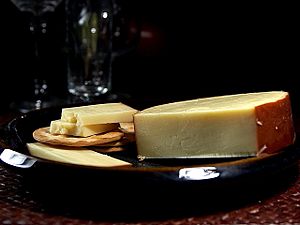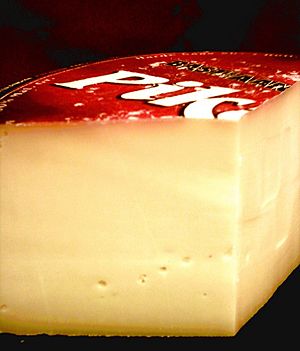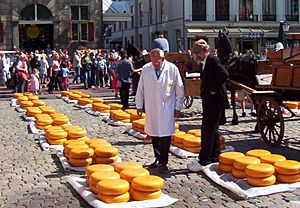Gouda (cheese) facts for kids
Gouda is a very popular type of cheese that comes from the Netherlands. It's made from cow's milk. This yummy cheese gets its name from the city of Gouda in the Netherlands, which is famous for it. Even though it's named after the city, Gouda cheese is made all around the world.
However, there's a special kind called Noord-Hollandse Gouda. This one is protected, meaning it can only come from North Holland. Even though the city of Gouda is in South Holland, many of the cows that make this special milk graze in North Holland.
Gouda comes in different ages. Young Gouda is usually between one and six months old. It often has a yellow or red coating made of paraffin wax. Older Gouda is usually sold with a black coating. It's more crumbly and has a stronger smell and taste.
There are also other kinds of Gouda. These include Smoked Gouda, which is a processed cheese with a smoky flavor. You can also find Leyden Gouda and spiced Gouda, which has different spices added for extra flavor.
The Story of Gouda Cheese
The first time Gouda cheese was mentioned in history was in 1184. This makes it one of the oldest cheeses in the world that people still make today!
The cheese is named after the Dutch city of Gouda, but not because it was made right there. Instead, it was because the city was a very important place for trading cheese. Long ago, in the Middle Ages, cities in the Netherlands could get special rights. These rights sometimes gave them a total monopoly on certain goods. This meant they were the only place where those goods could be sold.
Gouda got the special right to have a cheese market. All the farmers from the area had to bring their cheeses to the market square in Gouda to sell them.
At the market, special teams of cheese-porters would carry the farmers' cheeses. These porters were part of a guild and wore different colored straw hats. They used barrows to carry the cheeses, which often weighed about 16 kilograms (about 35 pounds). Buyers would taste the cheeses and then negotiate a price. They used a special ritual called handjeklap, where buyers and sellers would clap hands and shout prices. Once a price was agreed upon, the porters would take the cheese to a weighing house to finish the sale.
Even today, farmers from nearby areas still gather in Gouda. They meet every Thursday morning from June to August to have their cheeses weighed, tasted, and priced. Most Dutch Gouda today is made in factories. However, about 300 Dutch farmers still make boerenkaas, which means "farmers cheese." This is a special, protected type of Gouda made the old-fashioned way, using milk that hasn't been pasteurized. Making cheese was traditionally a woman's job in Dutch culture. Farmers' wives would teach their daughters how to make cheese.
How Gouda Cheese is Made

The word "Gouda" actually describes a way of making cheese, not just one specific type. This is why its taste can change a lot depending on how old it is. Young Gouda, especially from factories, tastes mild and a bit like nuts. But older Gouda, made on farms, can have a lovely fruity taste and a sweet finish. If it's aged for more than two years, it might even taste like butterscotch!
Here's how it's generally made: First, milk is cultured and then it curdles, forming solid bits called curds. Some of the liquid, called whey, is drained away. Then, water is added. This step is called "washing the curd." It makes the cheese sweeter because it removes some of the lactose (milk sugar). This means less lactic acid is made.
About 10% of the mixture is curds. These curds are then pressed into round molds for several hours. These molds give Gouda its classic round shape. After that, the cheese is soaked in a salty water solution called brine. This gives the cheese and its rind a special taste.
The cheese then dries for a few days. After drying, it gets a yellow coating to stop it from drying out too much. Then, it's aged. During aging, the cheese changes from being semi-hard to very hard. Dutch cheesemakers have six main ways to classify Gouda based on its age:
- Young cheese (4 weeks old)
- Young matured (8–10 weeks old)
- Matured (16–18 weeks old)
- Extra matured (7–8 months old)
- Old cheese (10–12 months old)
- Very old cheese (12 months and more)
As Gouda gets older, it develops a sweet, caramel-like flavor. It also gets a slight crunch from tiny cheese crystals, especially in older cheeses. In the Netherlands, people often eat cubes of Gouda as a snack. They sometimes serve it with Dutch mustard. Older types of Gouda are sometimes eaten with sugar or apple syrup. Very old Gouda cubes are often enjoyed with strong beers or port wine.
See also
 In Spanish: Queso gouda para niños
In Spanish: Queso gouda para niños




